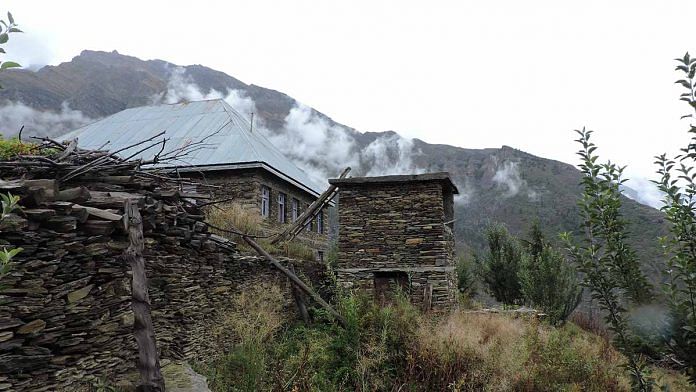New Delhi: The bacterium species Glutamicibacter arilaitensis, which was first found in a French cheese, is being used by researchers to improve the composting process and save the water-conserving traditional dry toilets used in the Himalayas.
The bacterium was first identified in the cheese Reblochon that is made in the Alpine region of Savoie from raw cow’s milk. However, over 6,500 km away in the Himalayas, a different strain of the same species has been helping farmers save water and practice sustainable farming for over a century.
Now, researchers at CSIR-Institute of Himalayan Bioresource Technology (IHBT) are using the same LJH19 strain of Glutamicibacter arilaitensis, a phychoropic bacteria, to conserve the dry toilets of Himalayas. Phychotropic bacteria can remain active in colder climates.
Freezing temperatures during winter months make modern toilets — which use flush and water pipes to transport human waste — useless. These toilets rely on running water, which often freezes at such high altitudes.
As a result, people have traditionally resorted to using dry toilets.
Megh Singh Pujaha, pradhaan (head) of the Gushal Village in Lahaul, Himachal Pradesh, and his family of 25 people are among the hundreds of households in the Lahaul and Spiti Valley that continue to use such dry toilets.
This traditional toilet is usually a small room with a hole in the floor, below which is a storage area where all the waste or night soil is collected. After every use, a dry mixture made of wood chips — locally known as fot — is used to cover the waste.
Around October every year, just before winter sets in and temperatures drop low enough for the night soil to freeze, it is removed from this storage area to be used as natural fertiliser.
Farmers have relied on naturally-occurring bacteria to degrade the wastes. However, the practice comes with several disadvantages.
“The area is extremely cold, so there are very few microbes that can function at such low temperatures. As a result, the quality of the compost is not as good as one would expect,” Sanjay Kumar, director of CSIR-IHBT, told ThePrint.
“Another disadvantage is that there is a foul odour around the house,” Kumar said.
Meanwhile, an influx of tourism in the Himalayas and the rise in use of modern toilets as a result, has put the availability of water in these areas under severe stress. For instance, in Ladakh, which also traditionally made use of these dry toilets, is facing a severe shortage of water due to tourists.
Even residents are shifting to modern toilets. According to Pujara, his ancestral home had a traditional two-storey dry toilet for over 100 years but his newly-constructed house has both the modern as well as the traditional toilet.
“In summer months, we use the modern toilets,” he told ThePrint.
Also read: On World Toilet Day, a look at India’s sanitation data and the ground realities
Bacteria to the rescue
In an effort to save these toilets, a team led by Rakshak Kumar, a microbiologist at CSIR-IHBT, has found a way to not only accelerate the composting process but also eliminate the odour.
The team first isolated bacteria from the compost provided by the villagers in Lahaul to identify species that were active at low temperatures (upto 4 degrees Celsius) and also possessed multiple plant growth-promoting (PGP) traits.
In a paper that is yet to be peer-reviewed, the team noted that Glutamicibacter arilaitensis LJH19 would be the ideal candidate for efficient degradation of night soil.
“Apart from these we identified other bacteria, and made a consortia of bacteria that could work together,” Rakshak told ThePrint.
“We also tested the bacteria for safety, since the bacteria are collected from human wastes,” he noted.
The bacterial consortium is mixed with some compost boosting material, which the team is looking to patent, that traps ammonia. Ammonia is a colourless gas that gives night soil its foul smell. This dry mixture is to be used to cover the waste after every use in place of the traditional fot.
The team has distributed samples of the mixture to hundreds of households across Lahaul and Spiti. Initial observations show that the mixture helped degrade the night soil better and reduce the odour.
Pujara noted that the amount of compost reduced by nearly 40 per cent after using the new mixture, and he also acknowledged that it helped reduce the odour.
“The cost of transporting the manure to the fields has reduced for me,” he said.
Also read: Use of public toilets costs slum dwellers 104 times what those with own toilets spend
Disease-causing pathogens killed by composting process
Dry toilets have been associated with risk of diseases as well, but Rakshak noted that the composting process gets rid of most of the disease-causing pathogens.
Composting usually proceeds through three phases. The first is the mesophilic or moderate-temperature phase, which lasts for a couple of days. In this phase, cellulose in compost is broken down into glucose.
The next phase is known as the thermophilic, or high-temperature phase, which can last from a few days to several months.
During this phase, pathogenic bacteria in the compost gets killed, said Rakshak.
However, the team is still working on studying the quality of the final compost. The project is jointly funded by National Mission on Himalayan Studies, Ministry of Environment, Forest and Climate Change and the Department of Science and Technology.
According to CSIR-IHBT Director Sanjay Kumar, the institute is in talks with locals who can form a start-up to commercialise the product.
Also read: Swachh Bharat toilets without sanitation is why Dalits are at the receiving end



